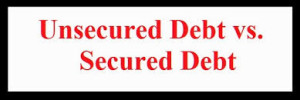When it comes to debt there are two main types, secured and unsecured. In Chapter 7 and Chapter 13 bankruptcy knowing the difference between both is very important so you can implement a proper plan. Even if you aren’t filing bankruptcy it is still good to know what the differences are between the debts.
First, what is secured debt? Secured debt is when something of value is used as collateral for a loan. If you fall behind on your loan payments the lender has the right to place a lien on what you used as collateral. This means they have the right to take ownership of it. Usually the lender will liquidate the asset and use that money to pay off what is due. However, if the selling price isn’t enough to pay off the debt completely the lender may then attempt to collect the difference from you, which is call or texted a “deficiency.”
Examples of secured debt:
- Mortgages – The loan is attached to the home and the home is the asset. If payments aren’t made the bank may take the home, known as a foreclosure
- Car loans – The loan is attached to the car and if payments are not made the bank has the right to repossession
- Auto loans and cash loans secured by a car title or other property
- Boat loans
- Furniture
So what do you do? You can obtain legal protection from creditors by filing bankruptcy. When you file Chapter 7 you have to decide if you will retain or surrender the property. You can only discharge secured debt if you surrender the property used as collateral. If you want to keep the property, you must continue making the payments. When you file Chapter 13 Bankruptcy it’s common that you will create a payment plan to make up the payments over a certain period of time while staying current on your regular monthly payments. For example, if you have a foreclosure on your house, filling a Chapter 13 bankruptcy will stop the foreclosure and implement a plan whereby you pay back the debt in increments until it is complete. To make the plan work you need to demonstrate that you will have enough income in the future to support the payment plan. If there were no legal proceedings or lawsuits brought against you before you file, filing bankruptcy sets forth a law that prevents the lender from bringing any lawsuits or legal proceedings, such as a foreclosure, against you. Additionally, you can sometimes use Chapter 13 bankruptcy to reduce debt to the replacement value of the property securing it, then pay off that debt through a plan. Therefore you are only paying what the asset is actually worth.

Next, what is unsecured debt? Unsecured debt is not tied to collateral and doesn’t result in repossession of the asset if you fall behind on payments. There is still an agreement to repay the lender but there is no asset. Therefore the debt isn’t attached to something that the lender can just take back. Instead lenders may take other actions in order to get you to pay. These actions may include the lender hiring a collection agency or taking you to court in order to get you to pay.
Examples of unsecured debt:
- Credit card bills
- Medical bills
- Personal loans
- Utility bills
- Pay day loans
How can bankruptcy help unsecured debt? Once you file bankruptcy collection actions will be suspended and you may be allowed to temporarily or permanently avoid paying any debts. These debts may be eliminated or a plan can be formulated so you can repay creditors while remaining under the protection of bankruptcy. Under chapter 7 bankruptcy some debts may be completely discharged while others mat not. If some debts aren’t discharged there may be a plan created to help pay it back over a period of time. Filing bankruptcy sets forth a law which generates an automatic stay on the debt. This means the creditors or debt collectors cannot push for the collection of debt. Once you file bankruptcy the creditors can’t harass you to pay the debt. Filing bankruptcy prevents that and buys you time to negotiate a plan to pay back the debt you owe.
Overall, bankruptcy is a powerful tool for debtors and a lot can be done to help out if you are facing financial hardships. Debt is a serious issue and knowing the differences between the kids of debt and what can be done about each is very important. If you have any questions don’t hesitate to contact Attorney Theresa DeGray at 203-713-8877.

